Claude Gordon Practice Routines (The Brass Herald)
A practice routine is a tool to become an excellent and consistent player. It also gives a scientific way to understand how to improve specific skills. These qualities are essential for a long successful career. Claude Gordon believed anyone could be a “virtuoso” if he knew how to practice.
Gordon took Herbert L. Clarke’s principles and applied them with more structure. My previous article defined the content and this article is about the practical application. The assignments serve to set goals and understand what causes the progress. Refer to the pictured assignment from Gordon and the explanation below. Even Gordon improved his teaching over the years by using this method.
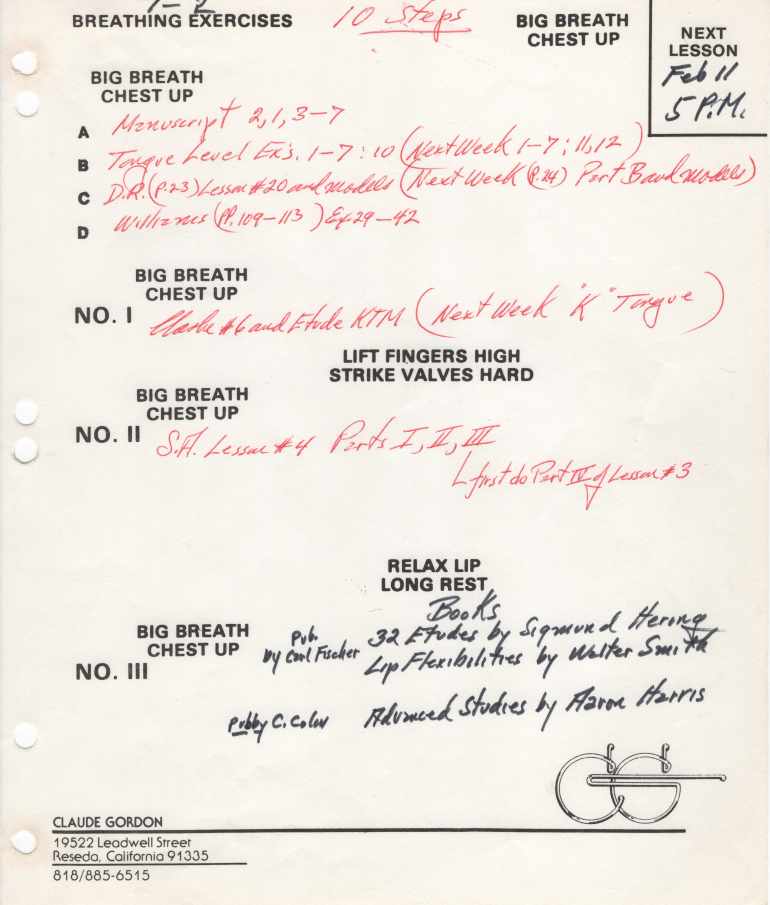
Breathing Exercises
Breathing Exercises are always the first item. The focus is on taking a “Big Breath” and maintaining the chest in an “up” position during both inhale and exhale. Forget about the stomach or diaphragm. If the chest stays up you cannot breath incorrectly. The first exercise is 5 sets of 10 breaths standing in place. The second exercise is called “5 Walking,” which is 5 equal sniffs-inhaling while walking, 5 holding-full, 5 puffs-exhaling, and 5 holding-empty, then repeating this cycle walking a square city block. Each month it progresses one more step, then after 10 walking it moves to 5 jogging until finally reaching 10 jogging. Another form of breathing exercise is the “long hold” in the “Range Study” section.
Order
Sections A through D of the CG assignment were usually flexibility studies, intervals, tonguing and scales. Tongue Level studies should usually be the first thing to play. Gordon said, “The air does the work; the tongue channels the pitch.” They develop flexibility and ease in navigating the instrument. It is similar to stretching before a physical sport to be flexible. Gordon’s Daily Trumpet Routines book is excellent to use with all the models. Other flexibility books like Colin, Irons, Walter Smith and Staigers may be used in this area too. The point is to “watch the tongue” and learn how to coordinate the wind power and tongue level to discover how to “let the air do the work”, as Gordon said, and not be focused on the lip. Collect all possible material in this category even from other instruments as Gordon did.
Section I of the CG assignment is where the fingers and breath control are developed while working on Clarke’s Technical Studies. The first priority is to “strike the valves hard and lift the fingers high”, which is mandatory. Do each study with seven days of each of the following: single tongued, K tongued, double (or triple) tongued, and finally slurring as written. Practice accurately to play accurately. Things should then be prioritized as follows: accuracy, evenness, speed, whisper soft playing and finally repetitions in one breath. Never play softer than you can get a secure sound. Other scales and arpeggio studies fit in this area too, but Clarke’s book should be reviewed at least annually. Refer to Gordon’s Systematic Approach book for the some of the fingerings from Clarke that were passed down to Gordon. These are mandatory to train the fingers to function independently of each other with speed and control.
How You Practice
“How You Practice” was Gordon’s label for a way of practicing technical etudes and problem passages. It involves starting on the last beat of the music and progressively working backward one beat at a time with four perfect performances in a row before moving to the next step. (Use diagram with steps.)
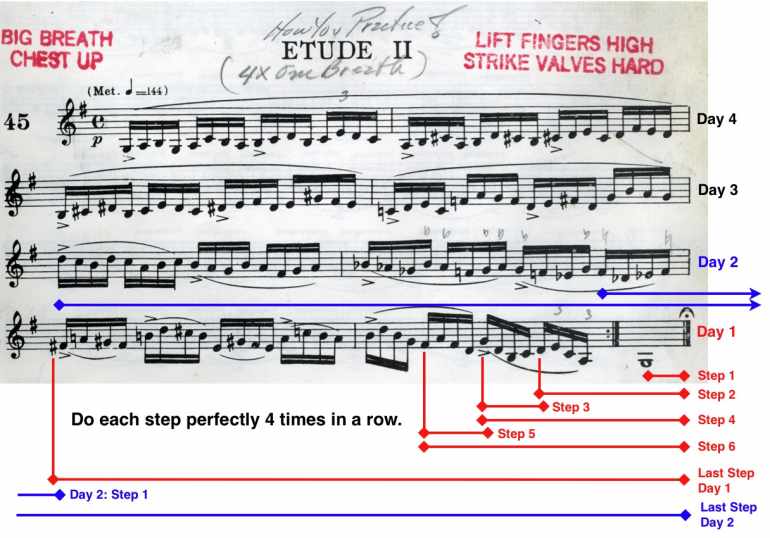
Range Study
Down Routine
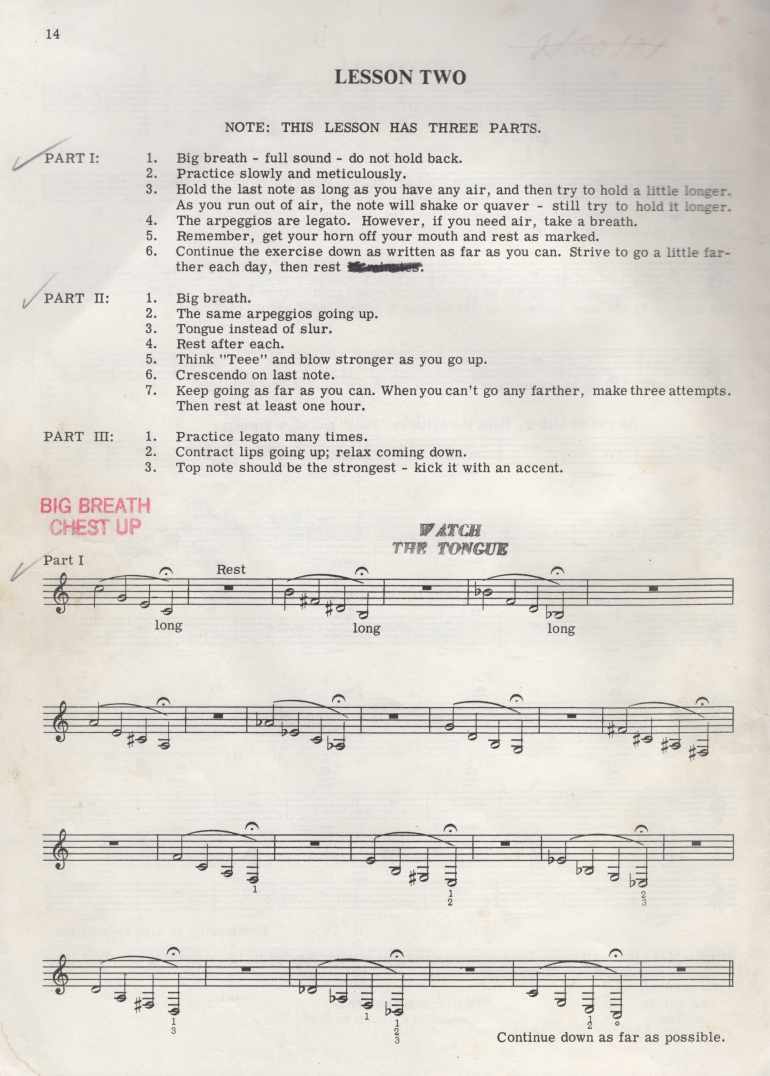
Section II of the CG assignment is the Range Study area. This takes the player first into the pedal tones (i.e. “Down Routine”), followed by a 5-10 minute rest, then to the high register (i.e. “Up Routine”), followed by a brief warm down (i.e. “Relax Lip”) and an hour long rest. All the other routine elements work along with the Range Study to increase the player’s range. The goal is a more playable range, usable in all situations.
Up Routine
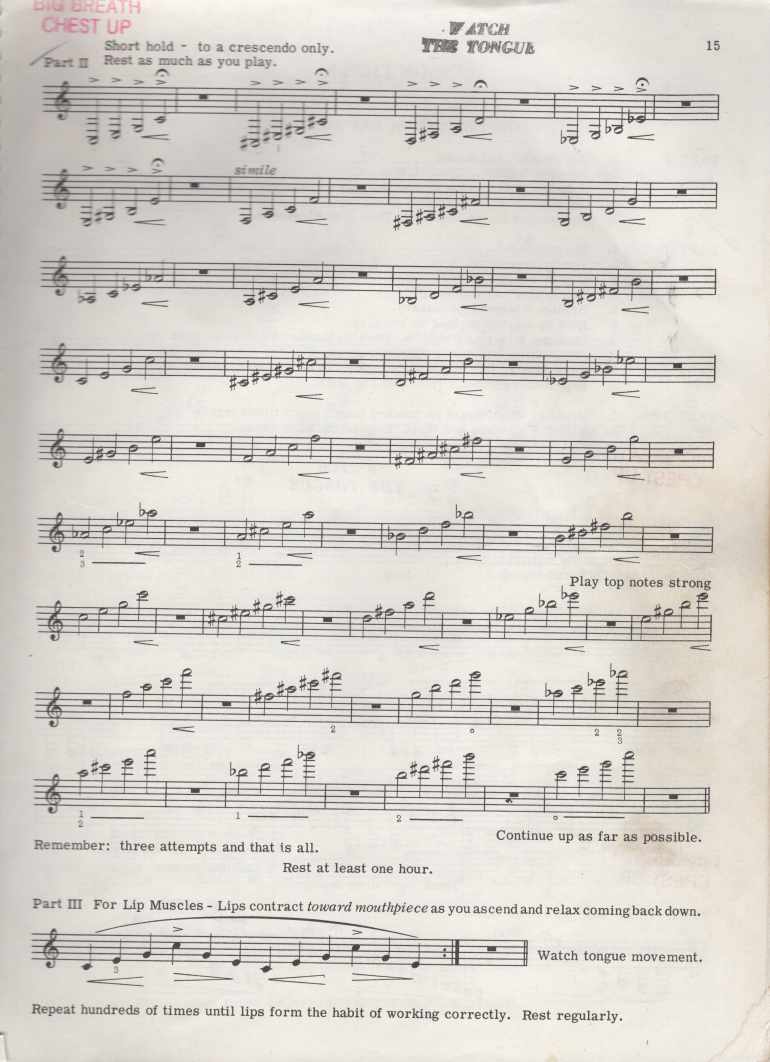
The “long hold” in the Down Routine is held until the sound stops and all the air is expelled. This is an isometric type of exercise that strengthens the muscles used for blowing. You never do a hold like that on high notes. The Down Routine played before the Up Routine helps the player discover how to play high with ease as opposed to tightness. Playing from pedals to the high register can be effortless if worked on systematically. The rests are not literally four beats, but you must rest as much as you play with the mouthpiece off the lips to avoid fatigue and bad habits that come from playing when tired. Gordon said, “If you rest properly you can play all day.” This also develops endurance by learning the knack of playing with ease instead of by brute force. “Watch the tongue” meant to visualize the tongue and feel it’s unique vowel position for every note. This is how you learn to play accurately. The “Eee” syllable must be in the very front of the tongue for faster air speed. Gordon said, “Let the air do the work and let the air save the lip.” This means to blow stronger when ascending to get the right feel. Pedal F through C# should be played in tune. Pedal C through Pedal F# are initially very flat for most people, but the pitch will come up in time. It is possible to play to the third pedal C or lower. The pedals help improve a free vibration of the lips and indirectly help many aspects of playing. Care must be taken to not play them too loud.
Start the Up Routine in the pedals. On the first arpeggio leave pedal C below pitch, but play pedal E in tune by sounding the note 8va to get a reference pitch before playing the arpeggio. This fermata should only be a brief hold with a crescendo. Rest between each key. Continue up as far as possible. Remember this is a calisthenic exercise more than a musical exercise. Work up as high as possible, making only make three attempts at the highest note and then stopping to avoid developing bad habits.
Relax Lip

“Relax Lip” was a brief warm down to be played 3x after the Range Study. It can also be played other times. After the Range Study and “Relax Lip” the player shouldn’t play a note for an hour in order to completely recover. It is also wise to not do the Range Study before a demanding performance.
Technique Applied
Section III of the CG assignment is where solos, etudes, orchestral excerpts and other music is placed. The Range Study can also be placed at the very end of the routine with the etudes before it.
There are other variations that can be made to the routine, but this is the normal way. See the article What To Practice on www.purtle.com for a list of books to use in the routines. The practice routines are how the player can learn that brass playing is no harder than deep breathing. It’s not luck or natural talent. After playing the routine you should feel better than when you started. The goal of the routine is to learn to play with ease.
There is a balance between staying too long on an exercise and loosing focus vs. not staying long enough for the exercise to accomplish the desired result. Sometimes the same items can be worked on with variations. A teacher can spot things we ourselves don’t notice.
Personal Use
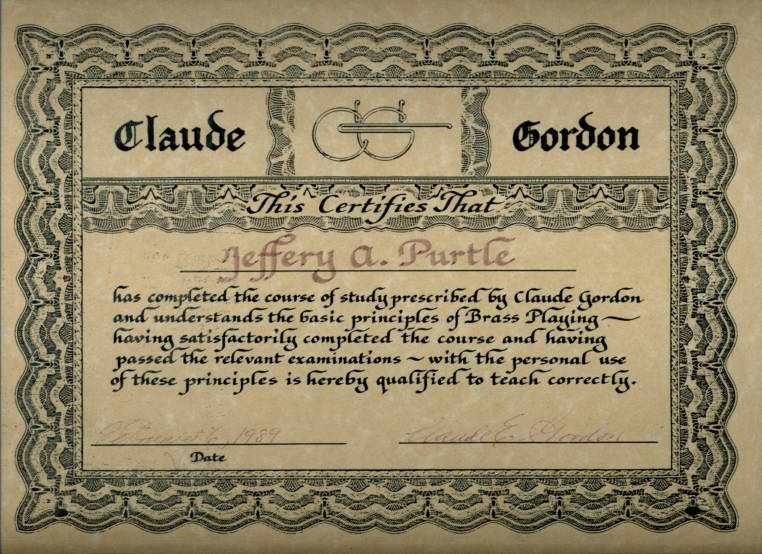
In order to teach correctly you have to play correctly and understand it. Gordon said the following on my pedagogy certificate from 1989, “...with personal use of these principles is hereby qualified to teach correctly.” Gordon knew that the teacher must be in tune with his own playing and practice in order to take students along the road to improvement.
What's Next?
The next article will cover Herbert L. Clarke’s admonition to Claude Gordon to “not stop where I’ve gone!” We must build on the foundations of these great teachers and not just repeat history.
Jeff Purtle studied for ten years with Claude Gordon, taught at the CG Brass Camps and was certified directly by Dr. Gordon to teach according to his principles. Jeff has taught since 1984 and in 2004 added live video chat students to his Greenville, South Carolina studio.
Published by The Brass Herald - February 2009


